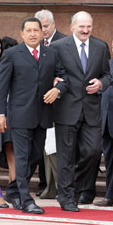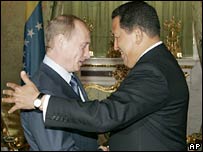ConTradeIctions
The more you think about the revolution's trade policy, the less sense it makes. On the one hand, we hear Chavez attack any country that considers a Free Trade Agreement with the US in the crudest of terms. On the other, we see Venezuela's bilateral trade with the US skyrocketing. Why? Because our one big export product already has tariff-free access to the US market...
In fact, Venezuela already has a kind of
de facto, rough and ready FTA with the US. Our major export product faces no market access issues up north. Under those circumstances, it's enormously fresh for Chavez to go aggro on any country that seeks to secure similar market access for its main export products via negotiations. No matter - petty political advantage is to be had, and Chavez is not minded to pass up any opportunity in that regard.
In fact, the La Paz-Caracas-Havana Juggernut's discourse on trade is as confused as confused can be. Think of the Cuba angle. For 45 years Fidel has been blaming any and every problem on the island on the US trade embargo. In official, fidelista discourse, then, it's the absence of trade with the US that makes countries poor. Ummmm...shouldn't Fidel be the hemisphere's number 1 fan of bilateral FTAs with the gringos, then!?
Nah, the cookie doesn't quite crumble that way. The Axis of Evo's guiding political principle is far cruder than that: whatever the US wants must be bad, whatever the US doesn't want must be good. They don't like free trade with Cuba? Free trade with Cuba must be wonderful! They do like free trade with Colombia? Free trade with Colombia must be the road to perdition!
Please comment responsibly:
|
The Un-Trade Agreement...
Well, thanks to Virginia I now have the text of the
People's Trade Agreement Venezuela, Cuba and Bolivia signed last month, and the thing is so amateur hour it's unreal.
Just for starters, the thing assumes you can just decree non-tariff barriers away - without the complex process of regulatory harmonization the process entails in the real world. For another, it just has no rules of origin. At all. All it says is "The governments of the Bolivarian Republic of Venezuela and the Republic of Cuba will immediately proceed to remove tariffs and other non-tariff barriers that apply to all imports within the tariff universe of Cuba and Venezuela whenever they apply to products originating in the Republic of Bolivia." It simply fails to address the question of what products, specifically, count as "originating in the Republic of Bolivia."
This is a dicier issue than you may think. Say Venezuela has a 30% tariff on widgets. Goods "originating" in Bolivia are now excempt from that tariff in the Venezuelan market. Now say Bolivia has only a 1% tariff on widgets. What's keeping an Argentine widget producer from exporting its widgets to Bolivia, paying the 1% tariff, and then selling on the widgets to Venezuela tariff free?
Nothing at all in this agreement, since the drafters just olympically skipped the definition of "originating in" - which is one of the most basic negotiating points in a Free Trade Agreement these days.
(For a taste of what a contemporary Rules of Origin agreement can look like, click
here.)
If you sign a free trade agreement with no mechanisms at all to prevent transshipment, you're effectively handing over control of your tariff policies to your trade agreement partner: whenever his tariff is lower than yours, importers will just ship the goods into your partner's territory, pay the lower duty, then transship the stuff into your country duty-free.
This is really Trade Diplomacy 101 - it's staggering how they just "missed" this little detail.
(On the other hand, there will be some handsome arbitrage opportunities out there for importers who figure out how to exploit this latest chambonada.)
Please comment responsibly:
|
Help
Can someone find me a text of the Tratado de Libre Comercio de los Pueblos? Google isn't helping me here...
Please comment responsibly:
|
Gringo dough makes Chavez go...
It's a shameless rip-off, but just for those of you who haven't seen it, I'm reproducing this graph of Venezuelan imports from and exports to the US, from
Miguel's blog.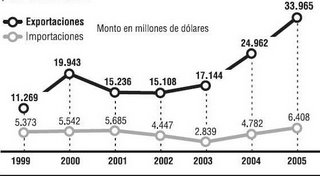
Just something to keep in mind as you read the piles of newspaper reports about how cash flush Chavez is. Hmmmmm...where are all these mountains of dollars coming from, anyway? From gringo drivers!
Please comment responsibly:
|
"No me ayude, compadre..."
Just a few weeks ago, it looked like the Castro-Chavez left was on a roll in its struggle for hemispheric supremacy against the Lula-Bachelet left. With Ollanta Humala on a roll in Peru and Lopez Obrador holding on to his longstanding lead in Mexico, the Anachronistic Left looked primed to add two big countries.
Things haven't quite gone as planned. First off, Humala and Lopez Obrador's challengers started making Chavez's meddling
an issue in the campaign. And the mudslinging has been
effective. Humala seems stuck about 10 points behind Alan Garcia in the peruvian polls, and even more startlingly, Lopez Obrador's lead has
evaporated. It's early day yet, no question, but it sure looks like Humala and Lopez Obrador would be doing much better if Chavez had just sat on his hands during the campaign...
Please comment responsibly:
|
Cassandra Chronicles
Just to prove that there's nothing creepier than a delusional paranoid with a long track-record of being right, here's Alberto Garrido's
latest column: Real Time
by Alberto Garrido
Though it hasn't come to a head yet, the continental polarization between Bush and Chavez has accelerated. On the one hand, the Chavez-Castro-Morales block decided to launch the socialist revolutionary triangle through pressure tactics on the energy front. Its space (for now) is the Americas, without national exceptions. The polarization pressed by Cuba, Venezuela and Bolivia puts an end to the interamerican institutional transition stage, because it clashes with its strategic interests, which are geared to establishing socialism on a continental scale.
The Andean Community is not necessary, because it helps the US on the road to FTAA, via the bilateral free trade agreements. By the same token there's no need for the Group of Three, Colombia-Mexico-Venezuela, because Mexico and Colombia have deals with the US.
Uruguay, disenchanted with "this" Mercosur run by Brasil and Argentina and edging to sign its FTA with Washington; Ecuador, which feels tempted to sign an FTA, like other countries that find themselves in similar situations, have gotten the message. Even Brazil and Argentina, which tried to use Chavez and Venezuela's oil as a way to softening up Washington and getting an FTAA Lite (i.e., one that solved their trade disagreements with the US), have to choose between what they understand their trade interests to be and their future energy needs.
Chavez's radical behavior goes far beyond the electoral - whether domestically or internationally. Humala didn't understand that. Much less have Lula and Kirchner digested it. The great continental polarizer is Chavez. This is the time of the States, but the time of the peoples is nearing, represented by parties or movements, even if those peoples have the petro-states as strategic weapons.
This is why the deal signed in Havana is the Free Trade Treaty of the Peoples. This is why Chavez says that the concept of "integragion" has to be changed in favor of "union", which comes closer to the bolivarian ideal of the greater fatherland. It's just that this union shall have to come about in the context of a socialist Latin America and Caribbean, and that strategy goes through a number of stages, among which the crucial one is the asymmetric resistance war against the US.
Without fully understanding what they're facing, the White House keeps, meanwhile, working on a hypothesis of "multiple wars" within the framework of a global war. This explains why Porter Goss has been jettisoned from the CIA, leaving room for Michael Hayden, a general from John Negroponte's team and one of the most hard-line hawks in the Reagan and Bush II administrations.
The Pentagon already controls almost 80% of the spying and intelligence budgets in the US.
Meanwhile, according to the Washington Post, Donald Rumsfeld has given the green light to setting up Special Forces in Latin America with "absolute freedom to act," as the Pentagon will not have to ask for permission from the State Department of those countries where they are stationed.
Let those who have eyes use their common sense.
Please comment responsibly:
|
Arroz con leche, te quiero proteger...
Con un subsidito de la capital...One last go at the WTO, and then I promise to get back to, um, writing things you all want to read about.
Accounts of the WTO invariably stress the comprehensive, global nature of the institution. Mentions of a "global trade deal" and the body's "149 member countries" pepper newspaper accounts. The WTO itself likes to stress its encompassing nature, which tends to give rise to some grandiloquent, sometimes apocalyptic rhetoric in favor or against the organization.
This whole discourse, while technically accurate, is actually quite misleading. It is true that, in some formal legal sense, WTO negotiations cover all trade topics for all 149 member countries. But, in practice, the impasse is over a quite limited number of highly protected products. In most markets, tariffs are already too low to have a really serious impact on the pattern or volume of trade.
This is especially true of industrial products: manufacturing tariffs average less than 3% worldwide. Only in textiles and clothing are there a significant number of "tariff peaks" that seriously distort trade. Elsewhere, tariffs are so low they barely register in producers' or consumers' decisions.
Even in agriculture, which is far more heavily protected than industry, tariffs and subsidies are far from evenly distributed. What you see is just a few products protected by very high tariffs - reaching up to 200% for milk imports into the EU and over 700% for rice imports into Japan - while most food trades much more freely:
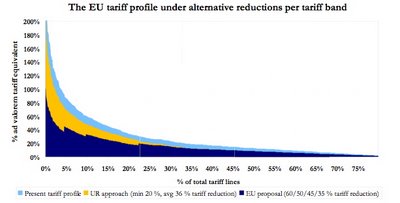 [The current situation is represented by the top (light blue) line. The dark blue line represents the EU's current proposal for dropping its tariffs.]
[The current situation is represented by the top (light blue) line. The dark blue line represents the EU's current proposal for dropping its tariffs.]The really bitter disputes, the ones leading to deadlock, are over the treatment of a handful of coddled products. Tariffs on rice, milk, and sugar make up a startlingly large chunk of the impasse. In a way, the unending deadlock is over rice pudding -
arroz con leche - the world's most distorted dessert. The three things you need to make yourself a nice
arroz con leche, together with a handful of other products (bananas, cotton, beef, chicken meat, and tobacco) make up a very small proportion of world trade, but account for a very large proportion of the rents generated by protectionist trade policies.
This explains why economic models simulating the impact of a new WTO deal usually predict relatively small welfare gains - around 0.15 to 0.4% of global GDP. In fact, most markets are already liberalized in most countries, so the additional impact from liberalizing the handful of holdouts is not very big.
The concentration of tariff peaks around just a few products also explains why agreement has been so hard to reach. The current system concentrates the benefits from protection on a tiny, cohesive group of farmers who find it highly profitable to organize themselves into lobbies in order to defend their rents. Those lobbies, lavishly funded and very well organized, come to dominate their countries' trade policy stances. In effect, the less you negotiate about, the harder it is to agree.
So don't be fooled by the headlines about "deadlock in global trade talks." What they're really deadlocked about is
arroz con leche...
Please comment responsibly:
|
Creative Diplo-bureacrats and their Little Boxes
One obvious feature of the Multilateral Trade Regime is its mind-numbing, technocratic, outsider-baffling complexity.
It's ironic, actually, because when the worldwide trade regime was launched in 1947, one of its big selling points was supposed to be its simplicity. At the time, economists blamed the severity (if not the onset) of the Great Depression on the self-defeating trade policies of the 1930s, when countries tried to gain an edge on their neighbors through competitive devaluations and increased tariffs. Without a single, straightforward, universal set of rules for trade, there was no mechanism to stop that process. Rather than replicating the baffling jumble of overlapping bilateral and regional trade treaties of the 30s, John Maynard Keynes and the architects of the Bretton Woods system thought it would be much better to have just a single, general agreement on tariffs and trade to cover trade between all countries.
Sixty years later, the system we have is, if anything, way more complex than anything the world saw in the 1930s. It's not just that the jumble of bilateral and multilateral treaties is back (the so-called
"Spaghetti Bowl" of Free Trade Agreements), it's that the WTO regime itself has grown incredibly complicated.
So what happened?! Well, six decades of letting trade creative diplo-bureaucrats swarm over the fine print of the original agreement, that's what happened. As the trade regime has grown to include more and more countries and deal with more and more issues, the agreements have inevitably gotten more and more complicated.
As more and thornier issues got thrown onto the WTO's plate, agreement became harder and harder to reach. Rather than accept deadlock, negotiators worked to finesse their differences creatively, by making finer and finer bureaucratic differentiations that allowed them to split the difference somehow. As the salami got sliced thinner and thinner, agreement became possible, but only at the cost of more or less giving up on the WTO's founding vision as a simple, straightforward, understandable set of rules for trade.
Archaeology of the Agriculture DeadlockThe clearest case of diplo-bureaucratic salami slicing is the whole, byzantine world of Agricultural Subsidy talks. The current, weirdly convoluted system dates back to the 1970s. It was already clear to trade negotiators back then that you couldn't liberalize trade in food just by lowering agricultural tariffs, because farm subsidies also played a major role in distorting markets. In fact, you can trace the heritage of the current deadlock in agricultural negotiations back at least 30 years. It all started in the Tokyo Round, the first time negotiators tried to strike a deal on farm tariffs and subsidies and failed.
Why? Well, at that time the point was fairly straightforward and understandable: rich countries subsidize farmers, the subsidies distort markets, therefore rich countries should stop subsidizing farmers. Only problem was, there was no way in hell rich countries would agree to that. So then the debate moved on to reducing farm subsidies, but that negotiation led to a deadlock as well. Discouraged, negotiators decided to focus on less controversial issues (industrial tariffs, mainly) and the Tokyo Round ended in 1978 with no agreement on agriculture at all.
By the time the next round of negotiations was launched in Uruguay in 1986, the debate on agricultural subsidies had been stagnating for eight years. This time, though, half the organization wouldn't agree to an overall deal unless there was some progress in agriculture, so pretty soon the diplo-bureaucrats realized they needed to get creative.
"Hmmmm," somebody thought, "this is a tough one. It's true that there are a lot of farm subsidies out there, but not all subsidies are created equal. Some farm subsidies really distort trade a lot - for instance, the ones that are paid on the basis of total output, and so create an incentive for farmers to overproduce outrageously. Those are bad, we want to get rid of those. But there are other ways countries subsidize farmers, for instance by paying them to maintain habitats for native wildlife. That doesn't distort trade! Maybe if we split subsidies into 'good' subsidies and 'bad' subsidies we can reach an accomodation where you limit the bad ones but leave the good ones alone."
Out comes the salami slicer, and in comes the first new classification. So they go back and negotiate on that basis for a while, and eventually realize it's still not leading to an agreement. So then another diplo-bureaucrat gets creative.
"Hmmmm, well, even the trade distorting subsidies aren't really all alike. Some are
really trade distorting, and some are only kind of trade distorting. Maybe if we differentiate between those, you'd have a basis for agreement. Hey, we could 'color code' them like a traffic light: red for really bad subsidies, amber (which is what Brits call a yellow light) for kinda bad subsidies, and green for good subsidies."
Thinking inside the boxThus the baffling-to-all-but-insiders WTO Subsidy "Box" system was born. Good subsidies would go in the "Green Box" and would not have to be cut. So-so subsidies would go in the "Amber Box" and would be limited but not eliminated. Bad subsidies would go in the "Red Box" and would be banned.
So then they go back into a little room and negotiate on that basis for a while. And, guess what, they still can't come to an agreement. Nobody likes the concept of a banned box, so the whole idea of a "Red Box" ends up getting tossed aside. The "Amber Box" comes to include all the highly trade distorting trade subsidies.
At the same time, all countries think they should have a minimal level of subsidies they can give without anyone being able to challenge them. Thus, the
De Minimis Box is created.
So they go back and negotiate on that basis for a while. But pretty soon the gringos realize they spend so much on trade distorting agricultural subsidies that they can't accept an Amber Box/Green Box/
De Minimis Box classification either.
So - you can already guess where this is going - they whip out the salami slicer again. This time they decide that maybe if they can create a new box to put some of the US subsidies into, then maybe they can reach an agreement.
Next thing you know, you have a
Blue Box, notionally housing subsidies that are worse than Green Box subsidies but not as bad as Amber Box subsidies. Everybody can see that the Blue Box is a trick - the subsidies the US wants to put in the Blue Box are just about as bad as Amber Box subsidies. But, politically, there can be no overall agreement without this one last slice of the salami. So, grudgingly, they agree to that.
And so, finally, eight years after the Uruguay Round started, they get an agreement...except the deal is based on an Amber Box/Blue Box/
De Minimis Box/Green Box classification that just makes no sense at all outside the context of the negotiating history of the Uruguay Round.
The current box scheme is just plain meaningless in economic terms, baffling to non trade diplo-bureaucrats, and miles and miles away from the principle of simplicity that the multilateral regime was founded on. Hell, even the original traffic light analogy has gotten all screwed up: who's ever come up to a stoplight with a yellow light, a green light, a blue light and a
de minimis light? Just screwy.
What interests me is the way the nature of the negotiations inexorably generates complexity in the system. The WTO is a consensus based organization: all members have to agree for a trade deal to become binding. So when there's deadlock, your only alternatives are creative solution making or giving up on the whole crazy Rube Goldberg machine.
Time and again, the creative solution makers win, and some new category is made up to allow countries to finesse their differences. The cumulative outcome, however, is a multilateral regime that only adds one layer of complexity after another with each new set of negotiations. John Maynard Keynes is rolling in his grave...
Please comment responsibly:
|



 Chavez Reelection Blog: Katy documents the government's use of public resources for Chavez's partisan advantage.
Chavez Reelection Blog: Katy documents the government's use of public resources for Chavez's partisan advantage.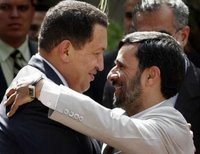
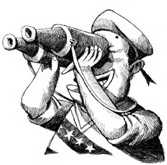
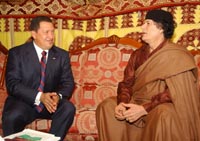
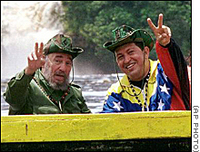
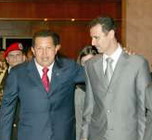
 Site feed
Site feed 